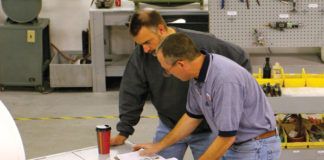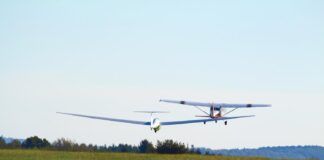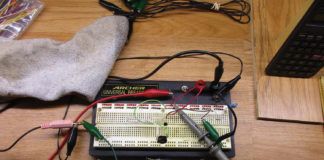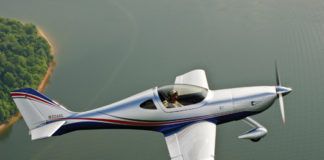Quiet on the set! yelled Patrick Reins, the assistant director. Then he looked around. Where are Dick and Sharon?
Were over here, we replied from behind the tree where we were trying to keep out of his line of fire.
You two come over here. He led us to a spot behind where he was going to be standing to direct the shoot. Then he stopped and drew a circle in the pine needles with his foot.
Now…you two stand here, don’t move, and don’t say anything!
Yessir, we squeaked.
He gave us a final stern look and went back to get ready for the shot. We were on the set of the film Amelia, which was being shot in the little town of Mt. Albert, about 30 miles north of Toronto. The beautiful little private grass strip was about 100 feet wide and 1800 feet long. On one side was a large field of waist-high wheat. On the other side of the runway was a long line of pine trees leading to a big red barn, a large hangar and several other airport buildings. It was a beautiful setting for what they were planning on filming. We were with the second unit, filming a part of the movie dealing with when Amelia as a young girl saw her first airplanes.
How did we get there? It all started with a phone call from Robert Baslee of Airdrome Airplanes. He wanted to know if we were interested in bringing Sharon’s replica Airdrome Airplanes Morane Saulnier L Parasol to Toronto to be used along with Roberts replica Bleriot XI replica. This was a no-brainer for us. Wed always wanted to see what went on behind the scenes of a movie shoot, and now we were going to see it happen live!
Here Comes Trouble
What we didn’t know is that there are a lot of ways you can get into trouble if you’re behind the camera. Before it was all over, wed been chewed on, yelled at and been given several stern looks by the director, assistant director and sound guy. The only thing that kept us from getting a grand slam was that we didn’t get gnawed on by the head camera director. We escaped on a technicality. Someone else in front of us was also caught in the shot, and while that poor soul was getting chewed on, we scurried out of sight and hid in the pine trees.
Robert had to have commercial pilots fly the planes in the movie, so he called on the two most experienced light-plane pilots he knew: Eric Presten and Harvey Cleveland. Eric and Harvey are both professional pilots with thousands of hours between them, flying hundreds of different aircraft. They flew Roberts four full-scale Nieuport 17s built for the movie Flyboys. Eric went over to England with Robert to help with the flying scenes in the movie. Harvey has flown all of Roberts WW-I replica aircraft and was the test pilot for the full-scale Nieuport 28 that appeared at Air Venture 2006. On this occasion, Eric was the Bleriot pilot, and Harvey flew Sharon’s Morane.
So, on June 10, we got up at 3 a.m. and started the convoy east for the 1200-mile jaunt to Toronto from Kansas City. Twenty-one hours later we rolled into Toronto. That counted two and a half hours in the customs/immigration offices getting Harveys permit to work in Canada. That was the ultimate bureaucratic nightmare. We ran into a whole bunch of SNBs (Shiny New Badges), who just had to show us how important they were and what bottom-dwelling scum we were.
Anyway, we rolled into Toronto the next day at about 1 a.m. By 7 a.m., we were at the field taking the planes off their trailers and putting them together. After a few test flights to make sure nothing was going to fall off in flight, we were to turn them over to the studio artists who were going to antique them so they looked old.
The only exciting thing that happened during the test flight was when we went to do a full-power runup on the Morane. Harvey was in the cockpit, with Sharon and me hanging onto it. When you pour the coals to the mighty Valley Engineering Big Twin four-stroke engine it has quite a pull.
Harvey cranked her up and the engine quickly settled into its 500 rpm, John Deere, plonk… plonk… plonk… plonk idle. After a few minutes to let all the needles find a green arc, he opened her up to full throttle. She immediately started shooting out an enormous cloud of white smoke. The studio crew was very impressed.
Whoa…Way cool, one of them said. Theyve got a smoke system.
The only thing was that we didn’t have a smoke system. Harvey said my face turned white as a new sheet from Dollar General. Acting like nothing was wrong, we shut her down and did a nonchalant look at the engine. This was weird. She had run fine with no misses and got full rpm. It was a puzzlement.
Harvey pulled the dipstick and found that she was waaaaay overfilled with oil. What idiot did this? he asked.
That would be me. That dipstick is hard to read, and when Id checked it, the oil level had seemed to be about a half quart low. It wasn’t. But Id added a half quart anyway. So again, nonchalantly, we drained a half quart of oil out and did another full-power engine check. All was well. The studio crew never suspected a thing.
Arting It Up
Time to let the studio artists have at it. Artist doesn’t quite cut it with these people. Magicians would be more like it. Ian Nelmes, key scenic artist, was in charge of matching the paint on both planes. With the Morane it was no big deal; we used Glidden Evermore Exterior Latex Apricot house paint on it, and that was an easy match. For the Bleriot, he pulled out an extensive book of paint chips and matched the color exactly. At about 10 that night, we all headed back to the hotel for a short sleep.
At 4 a.m. we were back on the set. The art guys were already hard at work on the airplanes. Overnight the art department had painted large sheets of sticky-backed paper with the color that matched the airplanes paint exactly. We were totally impressed.
By 5:30 a.m., the planes were ready for filming. Sharon’s Morane had been transformed from a thing of beauty to a flying drudge. But, as Ian said while he was slapping black paint on the cowling (as Sharon was forcibly restrained in the background), We can only have one star in the movie, and this plane is not it. He kept reassuring Sharon that the paint washed right off with water, but she was not believing it.
By 6:30 the whole 80-person shooting crew had arrived, and it was time to go into action. The first scene we were going to shoot involved the Bleriot and Amelia on her horse. They were supposed to come down the runway side-by-side for about 10 or 15 seconds, and then the Bleriot was supposed to lift off while Amelia stopped her horse and watched the plane climb out.
Sounds Simple, Eh?
Two hours later and on the eighth take, it wasn’t simple anymore. Wed discovered a new and wonderful ground handling characteristic in the Bleriot. It does not have a steerable tailwheel like the Morane. It doesn’t even have a conventional tailskid. Just like the original 1911 Bleriot, it had two hoops at the rear of the fuselage that slide along the ground. To make it even more exciting for the pilot, these two hoops contact the ground at an angle far from vertical. This basically means that when you pull the throttle back and there’s no more prop blast on the rudder, the pilot suddenly becomes a passenger. It was like watching an ice cube being dropped on a hot skillet. It could go anywhere.
Pretty soon we had developed a ground handling method that had to be seen to be believed. Eric was flying the Bleriot, so wed stationed Robert and Harvey at one end of the strip to turn the plane around after it had finished its landing roll. At the other end of the strip where the scene was to start, Sharon and I were there to turn Eric around for the start of the takeoff roll.
In the air, the Bleriot was performing well. The VW engine with the Valley Engineering PSRU and Culver prop was working just fine. There was power to spare. On takeoff after the tail came up and the rudder could bite, ground handling was satisfactory, too.
But landings were, to say the least, exciting for all. Sooner or later, Eric had to pull the power back and thats when the Airdrome Airplanes ground handling crew got out the red capes and got ready to yell, O Lay. Most of the time the plane would veer to the right as soon as the tail came down. But we were never sure, so the ground-handling crew would stand in the middle of the runway about 50 feet apart and get ready to play catch-a-plane.
Eric would come down the runway tail high so he could see and have enough air going by the rudder to steer. Then about 100 feet from us, hed kill the engine and then just sit back and hang on. There was nothing else he could do except watch and scream. The matadors would run toward the wingtips. No matter which way the plane swung, wed grab the wingtip that would turn it back to the runway and just hang on for dear life until the plane came to a stop.
Early in the day, it was pretty easy to do. But later on, when the wind came up to a gusty, quartering tailwind from the right, it got downright hairy. The plane wanted to swing to the right anyway, and with the added impetus of the tailwind, the swing was fast and abrupt. At Robert and Harveys end of the strip, the crosswind was from the left and the swing to the right was a lot gentler. Besides that, the swing took the plane into the wheat field. By the time the plane got to the field, it was going slow enough that even if it went into the wheat, itd just stop and not go over on its back. At our end of the field, a swing to the right took you right into a line of pine trees. They were not nearly as forgiving as the wheat.
That Your Friend in the Chipper?
The one time thats forever seared into my memory banks was when a gust of wind hit the plane just as the tail came down and those miserable hoops hit the ground. It swung to the right abruptly and started for the trees.
Stop me! Eric yelled as he hurtled toward the trees.
I heard the thunder of feet as Sharon bailed and dove out of the way. I cant remember what I yelled, but several crew members came over and said theyd never heard those particular words before and wanted the correct spelling. Well leave it at that. As the wing rushed at me, I grabbed onto the front spar and hung on as I got dragged along the ground. A few seconds later, it was over and all was well.
The assistant director came over to me and said, Dang, buddy, are you all right?
I said I was fine. Then the camera guy came over and asked the same thing. I couldn’t understand what they were talking about until Sharon told me that to them, I was a hero for sacrificing my pink little body to stop the plane like that. What they didn’t know was that I grabbed the wings leading edge spar to try and keep the spar from knocking out my teeth. Being a hero had nothing to do with it. I just wanted to be able to chew my food in the future.
There were some scenes with the Bleriot, the horse and a camera helicopter that I think went quite well. Coordinating the three of them took some doing and many tries, but the last shot was perfect. The rising gusty winds ended any Bleriot flying for the day. The plane and Eric had outdone themselves. Eric had done a job that I don’t think any other pilot could have done with that particular plane. I will say that future models of the Bleriot did have a tailwheel, but they wanted this one to look authentic for the period. Thats why the hoops were there.
By comparison, Harvey and the Morane were anticlimactic. The plane did everything they asked and more. The director asked Harvey if he could fly a pass where the shadow of the plane would cross over the young Amelia where she was lying in a wheat field, looking up at the sky. I could almost see that Harvey wanted to ask the director if he wanted the wings shadow or the fuselages shadow to pass over her. Thats how good he is. They did take after take of that shot, and Harvey never missed her with the shadow. They did it at all different altitudes and from different entry angles. For one shot, Harvey flew under the camera on the tall extended camera boom.
Uh-oh.
The first take was the one that proved he could do it. It was also during the first take that Sharon got noticed by the director. Ill rebuild the scene for you right now.
Quiet on the Set
The young Amelias lying in the wheat. There are about 80 people behind the scenes running cameras, holding reflectors, pushing and pulling the camera trolley, running the boom, following the script, etc. It was a mob scene.
In charge of it all… was the director…Omnipotent Ruler of all he surveyed. No one wants to do anything to disturb the shot and get noticed by the director. Which now sets the scene for Sharon’s personal Waterloo on location.
It was time for Harveys first attempt to pass the planes shadow over the young Amelia. Harvey started his run and the movie litany began: Quiet on the set…camera…rolling…action!
Harvey passed in front of us and his shadow went right over the girl in the wheat. Sharon squealed, He did it, he did it! Eighty pairs of eyes swiveled in her direction, including the directors. His were bugged out in incredulous outrage. He put his fingers to his lips and hissed like an aggravated anaconda about ready to strike: Shhhhh!
Sharon ducked behind me and tried to use me for cover, but I wasn’t having it. I ducked away, but she still stayed behind me as we scuttled away like a pair of fleeing hermit crabs out of the line of fire. Patrick Aries, the assistant director, came walking by and said, Were going to have to shoot it again… because of Sharon.
Sharon moaned, Oh, no. Im soooo sorry.
Patrick grinned and said, Just kidding. We always do several shots of a scene, and the scene had already ended, but we never talk until we hear the director give the all clear. Besides that, we found out later, they could remove her voice in the cutting room.
But from then on we were a marked pair on the set. Someone with authority was always nearby to tell us where we could stand and watch. We were definitely staying out of the directors sight. When it came to stopping the Bleriot, Paul Pitch Molnar, the air boss of the shoot put out the word that we would be on the runway, period. No one but us would be working with or handling the aircraft. Theyd just have to accept that fact and alter the camera angles or whatever to fit what we were having to do to stop the Bleriot from going in the wheat or into the trees.
Pitch was a nice guy to have around. He works for Top Aces, a company that specializes in providing a variety of aviation services, and he was a good choice for air boss at the filming. He was the final word on aircraft safety and did not let anyone push him around.
Like I said, the Morane did us proud. But when they wanted the camera helicopter to follow Harvey around for a takeoff, passes over Amelia in the wheat, and through a landing, it could have gotten hairy if it hadn’t been for Pitch putting his foot down. They had a long briefing, and he told the chopper pilot to stay well back from the Morane to keep his downwash from messing up the Moranes elevators. From then on, all was well. We finished up two days of shooting in one because the weather was going to the dogs the next two days. They made the last shot and started taking down all the props and gear. The crew started to load up the semis with equipment and headed back to the studio in Toronto. It had been a very long day from 4 a.m. to 8:30 p.m. We were whipped.
The second unit was heading to Halifax for the next onsite filming, and from there to South Africa, where I think theyd found an actual flyable Lockheed Electra. Sharon and I went up to the director to apologize for talking during the shadow shot. He shook my hand and said, Shoot… It wasn’t like you were the only ones. The next day we took the planes apart, put them on their trailers and started the long 1182-mile drive back home. There was one bright spot on the return trip. We spent only 30 seconds in the customs port heading back to the good old U. S. of A., where you buy gas by the gallon and not by the liter. I never did get that straight.




